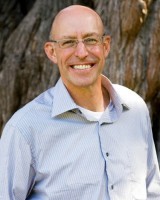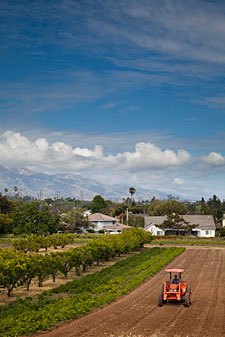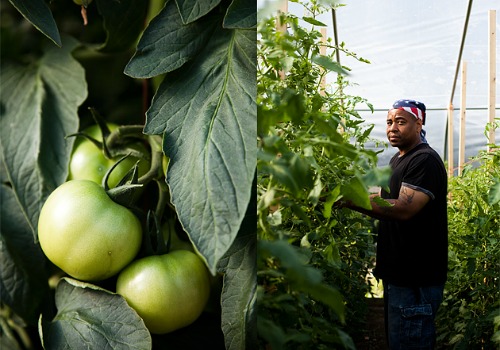January 2011 update: Many of the photos have been removed from this series so they can be published in a Breaking Through Concrete book, forthcoming this year from UC Press.
By David Hanson
A grease bus breaking down in Berkeley is like having a Mac glitch at Steve Jobs’ house during the Apple Chirstmas party. Within a few hours of Lewis refusing to start, the small world of urban farmers and veggie diesel mechanics swung wide open.
 Kurt Williams, mechanic from Oakland, resuscitates Lewis.Craig Reece arrived first on the scene, via cell phone. Craig runs PlantDrive.com,* a vegetable grease store of sorts. Craig sells conversion kits and components for people running waste vegetable oil in their diesel vehicles. Though we’d never met, Craig talked me through the engine and the triage process for Lewis.
Kurt Williams, mechanic from Oakland, resuscitates Lewis.Craig Reece arrived first on the scene, via cell phone. Craig runs PlantDrive.com,* a vegetable grease store of sorts. Craig sells conversion kits and components for people running waste vegetable oil in their diesel vehicles. Though we’d never met, Craig talked me through the engine and the triage process for Lewis.
Craig also recommended a few mobile mechanics. The second to show up was Billy, on his bike with pannier bag full of tools. Billy is one of the nicest men on earth. He looks a bit like Jack Black and John Belushi in his mechanic’s Dickies, Converse shoes, and heavy flannel coat. He speaks softly and deliberately; his voicemail says he is “delicately working on a car.” Billy is also the boyfriend of Novella Carpenter. Novella works at Biofuel Oasis in Berkeley, a biofuel station and urban farming shop run by five women. Novella has become a big name in the urban farm world since her book Farm City came out and chronicled her exploits and experiments with raising goats, ducks, pigs, and other livestock and fowl in Oakland vacant lots. (Read Grist’s interview with Carpenter.)
Billy searched Lewis Lewis for over an hour. Nothing. He returned the next day, this time in his red Mercedes grease sedan that looked as if it spends nights in an exhaust pipe. No answers yet again.
Eventually, a few days later, we got Lewis Lewis running. (Here’s a silly video of how we spent some of the time waiting.) We can’t begin to describe how happy we are to have him back. On our way out of waste-vegetable Shangri-La, we filled up with 100-plus gallons of greasy gold from Craig and headed south into the California night, stopping at 2 a.m. beside a classic example of large-scale monocropping — miles of potato fields sown by equipment larger than Lewis Lewis. We woke early and rolled out before coffee could brew.
A farm in the heart of Santa Barbara’s suburbs
By Edwin Marty
Edwin joined us for a four-day stint, beginning at the Fairview Gardens in Santa Barbara. He then rode with us in Lewis Lewis for a limping trek across the southern Cal desert and into Flagstaff before returning to his family and farm.
I’m standing in the last patch of working production farm in the once-verdant Goleta Valley. We’ve arrived at Fairview Gardens just after dawn, and the farm crews are heading into the fields.
Toby McPartland, the farm manager, gives us a survey of the 12-acre urban farm nestled amongst suburban houses in the heart of Santa Barbara.We walk slowly among avocadoes, peaches, plums, figs – all the wondrous fruit that used to be commonplace in the Goleta Valley. Annual vegetables form geometric lines between the orchard rows. Chickens wander the farm like they own the place. I breathe in the beauty, a different world from my home in Birmingham, Alabama, where I have my own farm. I started Jones Valley Urban Farm eight years ago on a vacant city lot. Today the working production and education farm encompasses three acres of vacant property in downtown Birmingham. I was there yesterday in the 90-degree southern heat for our second annual Slow Food Fair. Dozens of local chefs, brewers, winemakers, and food artisans shared with our community what food in central Alabama should taste like.
It’s nice to be here on the Fairview Gardens farm where, in the post-dawn cool, I can relax and appreciate someone else’s work and the history behind this beautiful growth. Unlike most urban farms in the country, Fairview has been a farm for the last 125 years. It’s one of our few examples that does not break through concrete; in this case, the farm came before the city. Housing developments and roads with increasing amounts of traffic sprouted where the avocadoes and plum trees once lined up. Fairview hung on, and the new suburban backyard walls hemming in the island of agriculture could not eliminate the traditional farm sounds, smells, and critters.
There’s an expectation of a certain order and “cleanliness” that accompanies suburban living. The farm’s realities — compost, tractor engines, roosters — were not considered amenities, despite the fact that Fairview produces fresh food available to all. Neighborhood tensions arose along with real estate pressure. In 1994 Fairview Gardens was saved from development through a conservation easement and the creation of a nonprofit organization called the Center for Urban Agriculture at Fairview Gardens.
Toby takes me to the freshly plowed fields waiting for the first rounds of summer crops. His vision for the future of the last farmland in Santa Barbara unfolds as he drops sunflower starts into the rich, dark soil.
“Fairview needs to be a model for small-scale sustainable farms,” he says. “We need to provide an example to young farmers that you can make a living on this scale of agriculture. If that happens, our urban spaces will be transformed by entrepreneurs reconnecting consumers with their food.”
This vision might seem like a bit of long shot. Prime farmland is still being developed on the periphery of every urban area and the scale of farms is increasing, not decreasing. The new director of Fairview, Mark Tollefson, has a complimentary view of the future of this farm — one that just might turn the tide of our globalizing food system. Fairview offers summer camps for kids and an apprenticeship program of workshops and courses for young farmers.
“We just need to have kids laughing on the farm. Once they understand the place of the farm in their lives on that level, everything else takes care of itself,” says Mark.
Mark’s own child, three weeks old, born on the porch of this farm hemmed in on all sides by the suburbanization of America, is laughing for us all.
*We here at BTC can and will plug businesses we like. We like PlantDrive. This entire post, in fact, has more product/people placements than a sitcom kitchen set.




